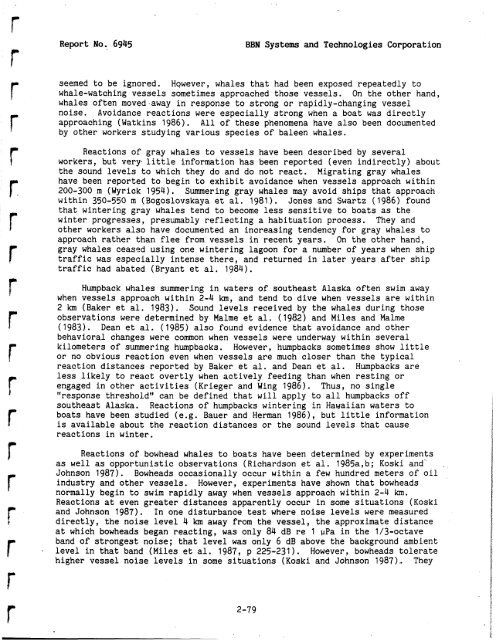Analysis and Ranking of the Acoustic Disturbance Potential of ...
Analysis and Ranking of the Acoustic Disturbance Potential of ...
Analysis and Ranking of the Acoustic Disturbance Potential of ...
You also want an ePaper? Increase the reach of your titles
YUMPU automatically turns print PDFs into web optimized ePapers that Google loves.
Report No. 6945<br />
BBN Systems <strong>and</strong> Technologies Corporation<br />
seemed to be ignored. However, whales that had been exposed repeatedly to<br />
whale-watching vessels sometimes approached those vessels. On <strong>the</strong> o<strong>the</strong>r h<strong>and</strong>,<br />
whales <strong>of</strong>ten moved,away in response to strong or rapidly-changing vessel<br />
noise. Avoidance reactions were especially strong when a boat was directly<br />
approaching (Watkins 1986). All <strong>of</strong> <strong>the</strong>se phenomena have also been documented<br />
by o<strong>the</strong>r workers studying various species <strong>of</strong> baleen whales.<br />
Reactions <strong>of</strong> gray whales to vessels have been described by several<br />
workers, but very- little information has been reported (even indirectly) about<br />
<strong>the</strong> sound levels to which <strong>the</strong>y do <strong>and</strong> do not react. Migrating gray whales<br />
have been reported to begin to exhibit avoidance when vessels approach within<br />
200-300 m (Wyrick 1954). Summering gray whales may avoid ships that approach<br />
within 350-550 m (Bogoslovskaya et al. 1981). Jones <strong>and</strong> Swartz (1986) found<br />
that wintering gray whales tend to become less sensitive to boats as <strong>the</strong><br />
winter progresses, presumably reflecting a habituation process. They <strong>and</strong><br />
o<strong>the</strong>r workers also have documented an increasing tendency for gray whales to<br />
approach ra<strong>the</strong>r than flee from vessels in recent years. On <strong>the</strong> o<strong>the</strong>r h<strong>and</strong>,<br />
gray whales ceassd using one wintering lagoon for a number <strong>of</strong> years when ship<br />
traffic was especially intense <strong>the</strong>re, <strong>and</strong> returned in later years after ship<br />
traffic had abated (Bryant et al. 1984).<br />
Humpback whales summering in waters <strong>of</strong> sou<strong>the</strong>ast Alaska <strong>of</strong>ten swim away<br />
when vessels approach within 2-4 km, <strong>and</strong> tend to dive when vessels are within<br />
2 km (Baker et al. 1983). Sound levels received by <strong>the</strong> whales during those<br />
observations were determined by Malme et al. (1982) <strong>and</strong> Miles <strong>and</strong> Malme<br />
(1983). Dean et al. (1985) also found evidence that avoidance <strong>and</strong> o<strong>the</strong>r<br />
behavioral changes were common when vessels were underway within several<br />
kilometers <strong>of</strong> summering humpbacks. However, humpbacks sometimes show little<br />
or no obvious reaction even when vessels are much closer than <strong>the</strong> typical<br />
reaction distances reported by Baker et al. <strong>and</strong> Dean et al. Humpbacks are<br />
less likely to react overtly when actively feeding than when resting or<br />
engaged in o<strong>the</strong>r activities (Krieger <strong>and</strong> Wing 1986). Thus, no single<br />
"response thresholdI1 can be defined that will apply to all humpbacks <strong>of</strong>f<br />
sou<strong>the</strong>ast Alaska. Reactions <strong>of</strong> humpbacks wintering in Hawaiian waters to<br />
boats have been studied (e.g. Bauer <strong>and</strong> Herman 1986), but little information<br />
is available about <strong>the</strong> reaction distances or <strong>the</strong> sound levels that cause<br />
reactions in winter.<br />
Reactions <strong>of</strong> bowhead whales to boats have been determined by experiments<br />
as well as opportunistic observations (Richardson et al. 1985a,b; Koski <strong>and</strong>c .<br />
Johnson 1987). Bowheads occasionally occur within a few hundred meters <strong>of</strong> oil<br />
industry <strong>and</strong> o<strong>the</strong>r vessels. However, exper.iments have shown that bowheads<br />
normally begin to swim rapidly away when vessels approach within 2-4 km.<br />
Reactions at even greater distances apparently occur in some situations (Koski<br />
<strong>and</strong> Johnson 1987). In one disturbance test where noise levels were measured<br />
directly, <strong>the</strong> noise level 4 km away from <strong>the</strong> vessel, <strong>the</strong> approximate distance<br />
at which bowheads began reacting, was only 84 dB re 1 uPa in <strong>the</strong> 1/3-octave<br />
b<strong>and</strong> <strong>of</strong> strongest noise; that level was only 6 dB above <strong>the</strong> background ambient<br />
level in that b<strong>and</strong> (Miles et al. 1987, p 225-231). However, bowheads tolerate<br />
higher vessel noise levels in some situations (Koski <strong>and</strong> Johnson 1987).. They
















